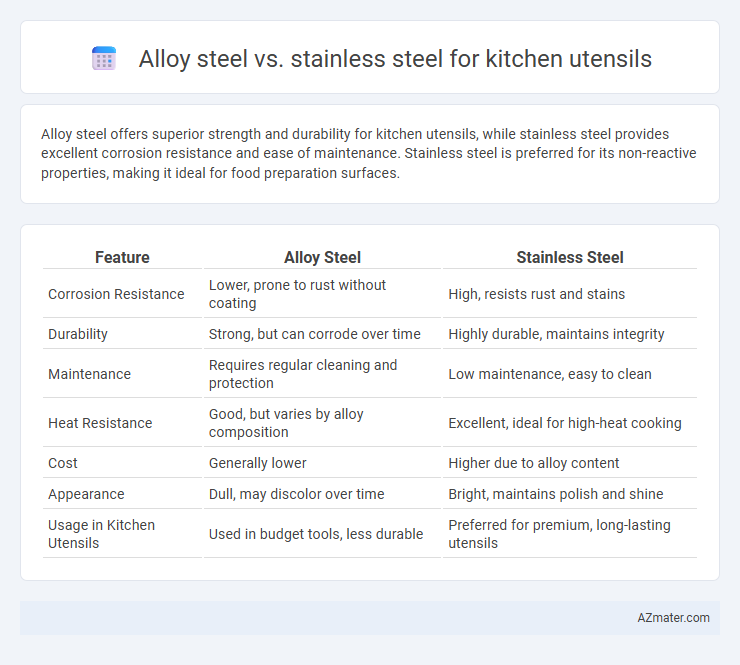Alloy steel offers superior strength and durability for kitchen utensils, while stainless steel provides excellent corrosion resistance and ease of maintenance. Stainless steel is preferred for its non-reactive properties, making it ideal for food preparation surfaces.
Table of Comparison
| Feature | Alloy Steel | Stainless Steel |
|---|---|---|
| Corrosion Resistance | Lower, prone to rust without coating | High, resists rust and stains |
| Durability | Strong, but can corrode over time | Highly durable, maintains integrity |
| Maintenance | Requires regular cleaning and protection | Low maintenance, easy to clean |
| Heat Resistance | Good, but varies by alloy composition | Excellent, ideal for high-heat cooking |
| Cost | Generally lower | Higher due to alloy content |
| Appearance | Dull, may discolor over time | Bright, maintains polish and shine |
| Usage in Kitchen Utensils | Used in budget tools, less durable | Preferred for premium, long-lasting utensils |
Introduction to Alloy Steel and Stainless Steel
Alloy steel, composed of iron mixed with elements like chromium and nickel, offers enhanced strength and durability, making it suitable for heavy-duty kitchen utensils. Stainless steel, a subset of alloy steel with a minimum of 10.5% chromium, provides excellent corrosion resistance and a shiny finish, ideal for hygienic and easy-to-maintain kitchen tools. Both materials vary in composition and properties, influencing their performance and suitability in culinary applications.
Chemical Composition Differences
Alloy steel kitchen utensils typically contain significant amounts of carbon, manganese, and sometimes elements like chromium and nickel, providing strength and durability but less corrosion resistance. Stainless steel, especially grades like 18/8 or 304, contains a minimum of 10.5% chromium and around 8-10% nickel, offering superior resistance to rust and stains through the formation of a passive chromium oxide layer. The higher chromium and nickel content in stainless steel enhances its chemical stability, making it more suitable for food contact and kitchen environments where moisture and acidity are common.
Corrosion Resistance Properties
Stainless steel exhibits superior corrosion resistance compared to alloy steel due to its high chromium content, typically above 10.5%, which forms a passive oxide layer protecting the surface from rust and stains. Alloy steel, while stronger and harder, lacks this protective chromium oxide layer, making it more susceptible to corrosion in moist and acidic kitchen environments. For kitchen utensils, stainless steel grades such as 304 or 316 are preferred for their excellent resistance to oxidation and chemical exposure, ensuring durability and food safety.
Durability and Longevity
Alloy steel kitchen utensils offer exceptional durability due to their enhanced strength and resistance to wear, making them suitable for heavy-duty use. Stainless steel utensils excel in corrosion resistance and maintain their appearance over time, contributing to superior longevity in moist or acidic kitchen environments. Both materials provide long-lasting performance, but stainless steel is often preferred for its rust-proof qualities and ease of maintenance.
Heat Resistance and Conductivity
Alloy steel exhibits superior heat resistance compared to stainless steel, making it ideal for kitchen utensils exposed to high temperatures without warping or degradation. Stainless steel offers moderate thermal conductivity, ensuring more even heat distribution in cooking applications, whereas alloy steel typically has lower conductivity, potentially leading to hotspots. Choosing between alloy steel and stainless steel for kitchen utensils depends on balancing the need for heat resistance and efficient heat transfer during food preparation.
Maintenance and Cleaning Requirements
Alloy steel kitchen utensils require regular cleaning to prevent corrosion due to their varying chromium content, often needing drying immediately after washing to avoid rust. Stainless steel utensils, especially those with high chromium and nickel percentages, resist staining and corrosion, making them easier to maintain with just routine washing and occasional polishing. Both materials benefit from non-abrasive cleaners to preserve surface integrity and extend utensil lifespan.
Aesthetic Appeal and Finish
Stainless steel kitchen utensils offer a sleek, shiny finish that resists tarnishing and maintains its bright appearance over time, enhancing modern and minimalist kitchen aesthetics. Alloy steel utensils, while durable, often require additional coatings or treatments to achieve a similar polished look and may develop discoloration with prolonged use. The superior corrosion resistance and smooth surface of stainless steel ensure a consistent and high-quality aesthetic appeal in kitchenware.
Cost Comparison
Alloy steel kitchen utensils generally offer a more affordable price point compared to stainless steel, making them a cost-effective choice for budget-conscious consumers. Stainless steel, particularly grades like 304 or 316, tends to be more expensive due to its superior corrosion resistance, durability, and aesthetic appeal. When weighing cost against longevity and maintenance, alloy steel may require more frequent replacement, potentially increasing long-term expenses compared to the higher upfront cost of stainless steel utensils.
Suitability for Various Kitchen Utensils
Alloy steel offers superior strength and hardness, making it ideal for heavy-duty kitchen utensils such as knives and peelers that require sharp edges and durability. Stainless steel, with its excellent corrosion resistance and ease of maintenance, is better suited for everyday items like spoons, forks, and pots that come into frequent contact with moisture and acidic foods. Both materials complement kitchen needs, with alloy steel excelling in performance-critical tools and stainless steel providing long-lasting hygiene and aesthetic appeal.
Choosing the Right Steel for Your Kitchen Needs
Alloy steel offers superior hardness and wear resistance, making it ideal for heavy-duty kitchen utensils that require long-lasting durability and strength. Stainless steel is corrosion-resistant and easy to clean, which ensures hygiene and maintains the utensil's appearance over time, making it perfect for everyday cookware and cutlery. Selecting the right steel depends on your kitchen tasks: choose alloy steel for performance under high stress and stainless steel for corrosion resistance and low maintenance.

Infographic: Alloy steel vs Stainless steel for Kitchen utensil
 azmater.com
azmater.com